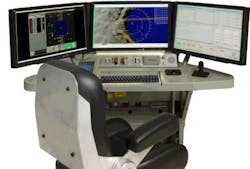General Dynamics to build multi-level-security Common Display Systems for Navy ships and aircraft
WASHINGTON, 2 March 2011. The U.S. Navy is ordering the Common Display System (CDS) -- a commercial off-the-shelf (COTS)-based Grade-A-shock-qualified display system for Navy surface ships, submarines, and aircraft -- from manufacturer General Dynamics Advanced Information Systems in Fairfax, Va., under terms of a $26.9 million contract modification announced Tuesday.The Common Display System is a family of information displays for all classes of Navy ships. It enables sailors to access software programs for different classification levels from any of these multi-level security consoles. This feature supports the Navy requirement to enable on display communications through multiple networked “chat” functions in classified and unclassified domains.Allowing users to access programs at several different classification levels from the same display system also helps decrease the number of systems necessary aboard a ship and reduces ownership and maintenance costs, General Dynamics (NYSE: GD) officials say. The company completed the critical design review for the CDS in April 2009.
Aydin Displays Inc. in Birdsboro, Pa., is providing display technology for the General Dynamics Common Display System. Aydin provides three 24-inch highly ruggedized displays for each General Dynamics CDS workstation.
The CDS is based on standardized, interchangeable components. Its software is designed in accordance with DODI 8500.2, and supports real-time operating systems, non-real-time operating systems such as POSIX, and co-hosts the Linux, Solaris, Windows, and LynxOS software operating systems simultaneously. It also supports multi-core processors and employs hardware assisted virtualization.
The CDS's open architecture is built for interoperability and helps enable frequent technology updates. It is part of the Navy’s Open Architecture Computing Environment (OACE) initiative to modernize the Navy infrastructure and reduce life cycle costs, company officials say.
The CDS equipment procurement provides a family of display systems that support the Navy’s implementation of open architecture for Navy combat systems. The CDS is designed around commercially available hardware and software and will provide computer displays to support combat systems on various Navy ships, submarines, and aircraft, with potential for U.S. Marine Corps and allied use, Navy officials say.
The CDS will meet the computer display requirements of other programs of record, including Aegis modernization. Awarding the contract were officials of U.S. Naval Sea Systems Command in Washington.
Features include modular design common to all display consoles; adherence to Navy MIL-S-901D shock test Grade A classification; operating temperature range of 0 50 degrees Celsius, and non-operating temperature range of -40 to 70 C; operation in 95 percent non-condensing relative humidity; support VESA timings and resolutions up to native WUXGA (1920 x 1200); support for as many as four live video streams at 30 frames per second at 640-by-480-pixel resolution each, or one video stream at 1920-by-1080-pixel resolution at 30 frames per second; six 1-Gigabit Ethernet 1000Base T network interfaces; and one dedicated IP network interface for Video over IP and two digital video interface (DVI)–I.
General Dynamics will do the work will in Fairfax, Va.; Tallman, N.Y.; Freemont, Calif.; and Smithfield, Pa., and should be finished by June 2013. For more information contact General Dynamics Advanced Information Systems online at www.gd-ais.com, or Naval Sea Systems Command at www.navsea.navy.mil.

